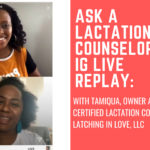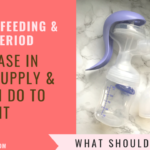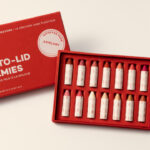New moms often ask me what they should add to their baby registry list. I used to send them my favorite store bought baby products since I knew that’s what they were looking for. However, I’ve changed up my list over the last couple of years to include more postpartum resources. Lactation services is just one of the musts we don’t think about often enough.

I was considering the best way to support moms being that we are going through one of the toughest times in recent history. I reached out to it’s essential for moms-to-be and new moms to put as many self-care procedures in place.
Thankfully, I’ve been fortunate enough to cross paths with a wonderful Certified Lactation Counselor. She’s helped me understand how this sort of support is in new mamahood.
I asked Tamiqua Torres, Certified Lactation Counselor and Owner of Latching In Love, LLC for some advice for new moms navigating the current climate.
I interviewed her and here’s some of the frequent questions she’s been answering in her line of work during COVID-19.
Can you tell us a little about yourself and your work?
Hi, I’m Tamiqua Certified Lactation Counselor and Owner of Latching in Love Lactation Services. Latching in Love Lactation Services provides both In-Home (if your local to Orlando) and Virtual Lactation Service Appointments to Lactating Families.
I am a wife and mom of 3 with a combined Breastfeeding Personal experience of 5 years. This includes breastfeeding while undergoing Cancer Treatment, Pumping at Work and Advocating for Breastfeeding Rights at work Protected under the Affordable Care Act. I’ve been helping Lactating Families for 8 years and left my full-time job in March of 2019 to work Full Time on Latching in Love Lactation Services.
How has your work shifted in light of COVID-19 and lockdown?
Maternal and Lactation Care has shifted to mostly Virtual Care. The world is starting to re-open. Some Lactation Professionals like myself have returned to do In-Home Lactation Visits depending on the area of the country.
Here in Orlando, I have returned to doing In-Home Visits with Families that need in person support after we have already had a Virtual Lactation Visit.
While the information on COVID-19 Pregnancy and Breastfeeding Mothers is consistently changing the latest information can be found on the CDC Website https://www.cdc.gov/breastfeeding/breastfeeding-special-circumstances/maternal-or-infant-illnesses/covid-19-and-breastfeeding.html
You can also find information on Breastfeeding and COVID-19 here on the La Leche League Website:
Can you share with us a couple of questions and concerns from new moms and moms-to-be during this time?
Here are 6 Commonly Asked Questions I’m answering.
Five questions are not only common but will be the beneficial considering that families released from the hospital now may have not seen hospital lactation specialists & may have little to no experience Breastfeeding/Chestfeeding. Plus, they may not have taken a Prenatal Lactation Course beforehand.
#1 How do I know my milk has come in?
Your body started to make milk between week 15-21 of pregnancy called Colostrum or Newborn Milk. Baby will consume colostrum during babies first latch. Your body starts the production of Mature Milk once the placenta is delivered.
Over the next 3-5 days after delivery colostrum will transition to mature milk. Colostrum is a thick “liquid gold” substance that provides everything baby needs and assists baby in releasing meconium.
Over the first few days your milk will become thinner as it transitions to mature milk. Look for your breast becoming engorged as a sign of your milk coming in, they may feel fuller and warmer.
It can be common for your body temp to rise as your milk comes in. Once your milk comes in, you want to be sure that you are emptying the breast completely. This is done baby latching to the breast and emptying them when feeding or that you hand express or pump.
#2 How do I know if baby is getting enough to eat?
Here are a few ways to make sure baby is getting enough. Baby is latched to the breast correctly. A deep latch where most of the areola is in babies’ mouth both upper and bottom lips are flanged out like a fish. You can hear baby swallowing; baby only takes brief pauses and your breast feel less full after the feeding.
Babies poops transition from meconium to seedy mustard yellow poop and has 6 or more wet diapers. It is normal for a breastfed baby to poop with every feeding.
As baby gets older, babies stooling habits can change. But for newborns, baby should be pooping every day. Baby should have at least 6 poop diapers once your mature milk has come in.
If at any point baby has blood in the stools or green stool you should consult your pediatrician. Baby meets his or her birthweight within the two-week appointment. If baby does not meet this or her birth weight at the two-week appointment, reach out to a Lactation Professional for a Latch Assessment.
#3 Should baby be fed on demand or every 3 hours?
Baby should be fed on demand and no longer than 3 hours during the day and 4-5 hours overnight. Watch for feeding cues like baby routing, moving head side to side, eyes fluttering when still asleep and moving head from side to side or placing hands in mouth, licking lips and sticking their tongue out. Crying is their last hunger cue.
If you notice that baby’s hunger cue is crying, try watching for the cues referenced earlier to see if baby is showing them earlier. Baby needs to go to the breast 8-12 times in a 24-hour period. In the beginning, it may feel as if baby is going to the breast every hour.
Feeding time can take anywhere from 15-30 minutes and sometimes longer depending on the baby. Be sure to have baby undressed when feeding baby. If baby is falling asleep at the breast during feedings, stimulate baby by stroking their feet or back. In addition, compress breast to initiate milk flow.
Please note that baby will likely want to go to breast for a variety of reasons not just to eat. Skin to Skin is highly recommended and encouraged. It not only helps to regulate baby’s body temperature, and blood sugar, but also promotes bonding.
#4 What’s cluster feeding?
Cluster feeding is when baby eats at shorter intervals than usual. Baby may go from eating at 2-3-hour intervals to wanting to eat every 30 minutes to 1 hour. The good thing is that cluster feeding only lasts a few days over a period of a few days.
You may feel like your breasts are lighter and worry that baby is not getting enough milk. But rest assured they are. A good reference for cluster feeding, growth spurts and baby leaps is the book and the app The Wonder Weeks.
#5 I want to continue breastfeeding, but it hurts, and my nipples are cracked and bleeding, what can I do?
The first thing you should do is contact a Lactation Professional. You can find one local to you by zip code using https://www.zipmilk.org/states/. Breastfeeding should not be painful and your nipples should not be cracked and bleeding due to feeding baby.
You can work with a Lactation Professional to have a Latch Assessment done to work on making sure that baby is latching to the breast and not the nipple. Feeding baby is vital but we don’t want you cringing at the thought of having to feed baby.
We know that if baby isn’t latched correctly, chances are baby may not be getting the amount they need. So, they maybe going to the breast often and causing more nipple damage.
#6 How to make more milk?
This is one of the most frequently asked questions and my answer is always “In order to make more milk you have to move your milk” Your milk production is based on supply and demand.
Your body knows to make more milk by bringing the baby to the breast often, making sure that your breast as empty after each feeding. Do not skip feedings or expressing your milk.
Going long intervals between moving your milk tells your body “I have enough right now you don’t need to make more” and the more you continue to do that the less milk you make.
In addition, here are a couple things you should know and be aware of when birthing your baby during COVID and once you & baby are home.
-You will be tested for COVID prior to delivery and if not. You will be treated as if you are COVID positive while at the hospital. Currently Hospitals are only allowing 1 person to remain with you. Depending on the hospital, they may be allowed to come and go while you and baby are there.
Depending on the hospital, if you test positive, baby may or may not be removed from your room while you are positive.
Each hospital has their own policy. So, please do not just consult your OB but the hospital you are planning on delivering at prior to delivery. Again, based on hospital protocol they are allowing mothers to breastfeed if they test positive for COVID. You can see the two resources I referenced earlier.
-Once you and baby are released your 2 week and 6- or 8-week Postpartum Visit will likely be virtual. I am recommending to all of my Prenatal Clients that they purchase a Blood pressure cuff so that they can monitor their postpartum blood pressure.
Use this checklist make sure you know the warning signs and when to call your doctor or 911. https://s3.amazonaws.com/website-assets-2020/wp-content/uploads/2020/02/01215318/pbwssylhandoutenglish.pdf.
I also recommend making sure the Pediatrician you are seeing is Breastfeeding Friendly. They may be the only provider that you are seeing in person. You can download a free resource on my website to help you determine if the Pediatrician you have will be able to help you and baby meet your lactation goals.
Where can we connect with you and learn more?
Website: https://latchinginlove.com/
Free Resources: https://latchinginlove.com/free-resources-1
Thanks so much Tamiqua for your expert advise and suggestions. Be sure to check her out for more information.













